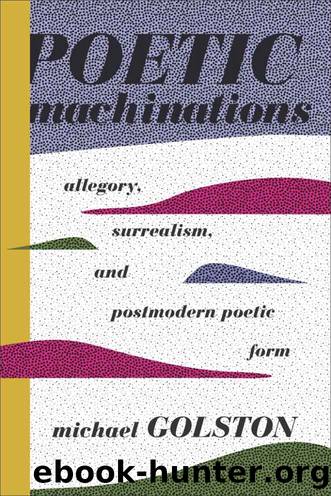Poetic Machinations: Allegory, Surrealism, and Postmodern Poetic Form by Michael Golston

Author:Michael Golston [Golston, Michael]
Language: eng
Format: azw3
Tags: POETRY / American / General, POE005010, LITERARY CRITICISM / Poetry, LIT014000
Publisher: Columbia University Press
Published: 2015-08-17T16:00:00+00:00
4
Semiologies
Susan Howe
I am, as far as I know, a pioneer, or rather a backwoodsman, in the work of cleaning and opening up what I call semiotic, that is, the doctrine of the essential nature and fundamental varieties of possible semiosis.
—Charles Sanders Peirce, “Pragmatism in Retrospect,” in Philosophical Writings of Peirce
Were any contemporary writer to imagine Charles Sanders Peirce as a frontier backwoodsman, it would have to be Susan Howe. Figuring the nation’s most neglected philosopher and the inventor of semiotics as an intrepid Daniel Boone bushwhacking through the American “word forest” fits almost too neatly Howe’s poetic praxis and her preoccupations with early American literature, which is robustly allegorical from its Puritan roots down to its mid-nineteenth-century “Renaissance.”1 It is curious that no critic has systematically approached Howe as an allegorist treating allegory, and although her inventive formal structures have been described as emblems and metaphors, only Charles Bernstein has labeled them allegories: in My Way he writes that “form in Howe’s work is allegorical, the lineation miming (mining) the themes of the poems” (1999, 100).2
Howe makes an interesting test case for my thesis because she doesn’t really fit it, although at first glance it looks as if she would or even should. Upon closer inspection, it is not at all certain that her work is allegorical at the level of form. Bernstein’s description more closely matches the definition of iconic form—where “form mimes meaning”—than of allegorical form as I have described it—that is, where a transcoded figure or metaphor systematically motivates a poem’s formal procedures. Rachel Tzvia Back tells us that “Howe’s poetic texts are themselves marked icons, whose textual marks are self-reflexively foregrounded” (2002, 3), and Craig Dworkin writes that “the visual surface of [Howe’s] pages illustrates at a literal, physical, spatial level the . . . lessons of the text’s thematic, semantic and conceptual planes” (1996, 396). Surely both are right. Howe’s is a visual poetics, derived ultimately, she has said, from painting; in much of her work, form bears some marked similarity—pictorial, analogical, or diagrammatic—to its subject matter: a poem’s form makes a picture or an image of its theme. Howe’s poetry thus differs categorically from the poetry of the writers whom I have discussed so far: although Coolidge’s poem Polaroid, for instance, behaves like a camera, it doesn’t depict one; the writing doesn’t form an image of film—it operates after the manner of it. In the works of each of these poets, form does not “resemble” content; it works out the logic of a metaphor. Such poetry systematically “introduces a metaphor into continuous series” at the level of form, the specifics of which are entirely prescribed by the metaphorical transcoding at its base. Thus, the form of Writing Is an Aid to Memory or of “nimr” is dictated by an ironclad formula that neither can be (nor at any point is) transgressed: the poet has set up a formal procedure that automatically unfolds according to the specifics of its own logic. There is nothing so
Download
This site does not store any files on its server. We only index and link to content provided by other sites. Please contact the content providers to delete copyright contents if any and email us, we'll remove relevant links or contents immediately.
The Power of Myth by Joseph Campbell & Bill Moyers(1000)
Half Moon Bay by Jonathan Kellerman & Jesse Kellerman(950)
A Social History of the Media by Peter Burke & Peter Burke(935)
Inseparable by Emma Donoghue(921)
The Nets of Modernism: Henry James, Virginia Woolf, James Joyce, and Sigmund Freud by Maud Ellmann(833)
The Spike by Mark Humphries;(764)
The Complete Correspondence 1928-1940 by Theodor W. Adorno & Walter Benjamin(746)
A Theory of Narrative Drawing by Simon Grennan(741)
Culture by Terry Eagleton(711)
Ideology by Eagleton Terry;(696)
Bodies from the Library 3 by Tony Medawar(680)
World Philology by(673)
Farnsworth's Classical English Rhetoric by Ward Farnsworth(672)
Game of Thrones and Philosophy by William Irwin(669)
High Albania by M. Edith Durham(654)
Adam Smith by Jonathan Conlin(648)
A Reader’s Companion to J. D. Salinger’s The Catcher in the Rye by Peter Beidler(645)
Comic Genius: Portraits of Funny People by(616)
Monkey King by Wu Cheng'en(609)
